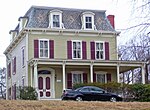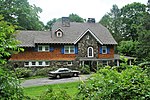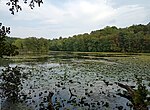Williams–DuBois House
Houses completed in 1780Houses in Westchester County, New YorkHouses on the National Register of Historic Places in New York (state)National Register of Historic Places in Westchester County, New YorkNew Castle, New York

The Williams–DuBois House is located at Grace Lane and Pinesbridge Road in New Castle, New York, United States. It was built by an early settler of the area during the Revolutionary War. In 1989 it was listed on the National Register of Historic Places.Originally built in the Georgian-influenced American Colonial style, it later acquired some Federal style decoration, particularly on the interior. The lunette windows on the second story may have been added later, after their use on a now-demolished local hotel. Despite later modifications, it is the only house from that era remaining in the town that has a gambrel roof. It remains a private residence.
Excerpt from the Wikipedia article Williams–DuBois House (License: CC BY-SA 3.0, Authors, Images).Williams–DuBois House
Pines Bridge Road, Town of New Castle
Geographical coordinates (GPS) Address Nearby Places Show on map
Geographical coordinates (GPS)
| Latitude | Longitude |
|---|---|
| N 41.185 ° | E -73.8275 ° |
Address
Pines Bridge Road 34
10562 Town of New Castle
New York, United States
Open on Google Maps









